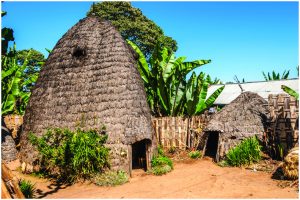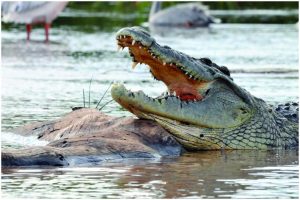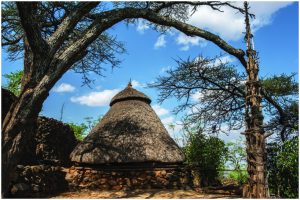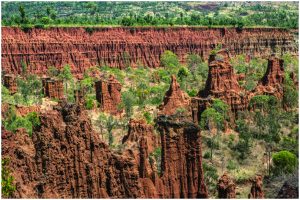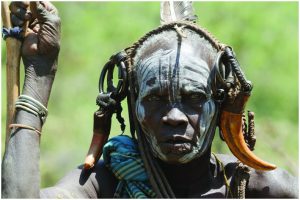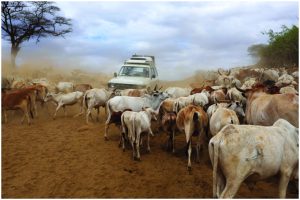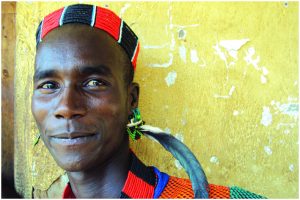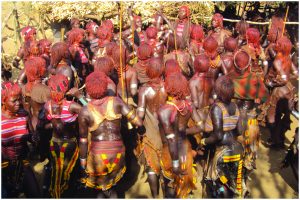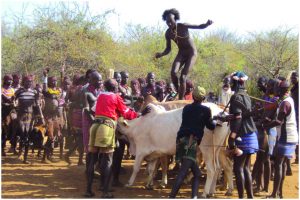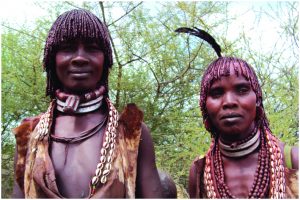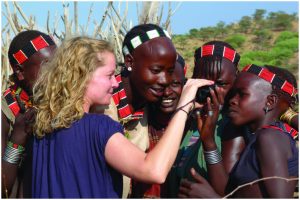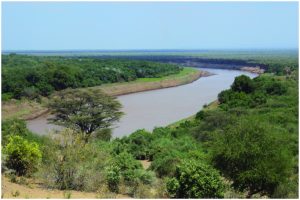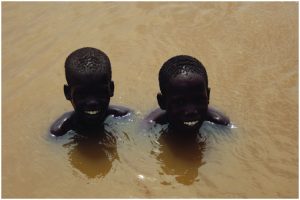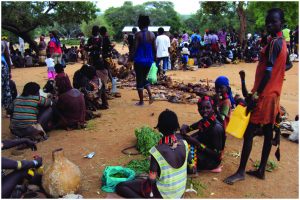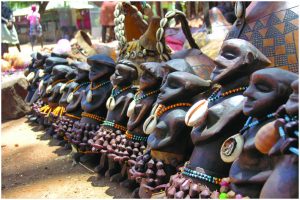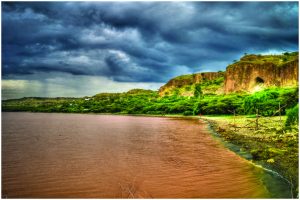Discover the Rift Valley & Deep South
In only eleven days you will be able to discover Ethiopia’s most exciting areas in the Rift Valley and South Omo Valley. Before visiting the colorful people, you will take a look at the wildlife around Arbaminch, including crocodiles, hippos and zebras. Afterwards you’ll get to know the culture of different tribes of the South Omo Valley, amongst other the Hamer people who celebrate vibrant festivals like the bull jumping ceremony or the evangadi dance. A trip to such a remote area will take you back in time. On the way back to the capital, you will have time to relax in the Rift Valley at Lake Langano.
Day 1 – Arrival in Addis Ababa
Depending on your flight you will have time for a city tour through Addis Ababa. Spend the night in Addis.
Day 2 – From Addis Ababa to Dorze
Start the day early because it is a long way down south. However, the landscape will make you enjoy the trip and let the time fly by. Because you reach Arbaminch, the biggest town and entrance to the South Omo Valley you will visit the Dorze people who live in a village up the mountains. In the Dorze village you will get the possibility to experience the traditional way of life of the Dorze people including special food, different architecture (bamboo elephant houses), weaving, a coffee ceremony, traditional alcohol, and you can take part in traditional dances yourself (it’s a lot of fun and a few shots of Arake before help to get ready). Don’t be shy and shake your booty to the Dorze rhythms. Spend the night in a small traditional hut in the Dorze Village.
Day 3 – Lake Chamo and Nechisar National Park around Arbaminch
Drive back to Arbaminch for a proper breakfast in one of the hotels and check in for the following night. After filling yourself you’ll take a short drive to the shore of Lake Chamo to take a boat ride across the lake. In the mornings you can watch the big Nile crocodiles that are sunbathing close to the shore. You will also be able to watch hippos, pelicans and many other colorful as well as seldom birds. After crossing the lake, you can hike up into Nechisar National Park to watch zebras, kudus, warthogs and gazelles. Take a lunch box from the hotel and enjoy the amazing view on the lake and the grass plains at the same time. You will be back in the late afternoon. Spend the night in Arbaminch.
Day 4 – Arbaminch via Konso to Jinka
Drive from Arbaminch to Konso and stop in between to visit local markets. Konso has a special way of building up its traditional village through which you will get a guided tour. The way of life and culture from the Konso people is very unique and it’s interesting to listen to the local guide who can answer all your questions. In the late afternoon, you will arrive in Jinka which is the entrance town to the Mago National Park where you can get to know the Mursi people.
Day 5 – Mago National Park to Turmi
Today you will drive deep into Mago National Park to visit a local village of the Mursi people. The 8,000 Mursi people are next to the Hamer the most popular in Ethiopia’s Omo Valley. They are well known for their unique lip plates. They are settled around the Omo River and in the Mago National Park. Due to the climate, they move twice a year between the winter and summer months. They herd cattle and grow crops along the banks of the Omo River. The Mursi women paint their bodies and face in white. They also are the ones who wear the lip plates. Women of the Mursi tribe may have their lips cut at the age of 15 or 16. A small clay plate is then inserted into the lip. Through the years, larger plates are inserted into the lip causing it to stretch. The larger the clay plate, the more the woman is worth before she gets married. It is said that the clay plates were originally used to prevent capture by slave traders. Although very unique and part of their tradition, the Mursi women only wear the plates for a short time because they are so heavy and uncomfortable. Men of the Mursi use white paint for their bodies and faces. Just like any other ethnic tribe in the lower valley, the men must pass a test before they can get married. A Mursi man is given a stick called a Donga and must face an opponent. The men then battle it out, beating each other with the sticks. The first fighter to submit loses and the winner is taken by a group of women to determine who he will marry. Men of the tribe also practice scarification. Like other tribes, this is the marking of an enemy killed by him. Although they are known to be aggressive and combative, the Mursi are more than happy to allow you to take pictures of them. However, they keep count of every picture taken and will charge you for each one. In the afternoon you will continue your drive to Turmi which is the central town on the Hammer people. Spend the night in Turmi.
Day 6 – Omorate, Dimeka and Turmi
In the Morning after breakfast you will drive to Omorate, which is the last border town in the upper Omo valley, only 30 km away from Kenya. Don’t forget to take your passport, because you will have to register before visiting the surrounding areas. Here you will cross over the Omo River in local boats to visit a village of the Dasanech people and get to know their culture and way of life. Also known as the Galeb or Geleb, this tribe lives just north of Kenya’s Lake Turkana. Their neighboring tribe is the Turkana people. The Dasanech are pastoralists (cattle herders), but due to the harsh territory, they have moved south to grow crops and fish. Cattle are used by the tribesmen for meat, milk and clothing. Often their cattle die from diseases and drought. Of all the tribes in the Omo Valley, the Dasanech are the poorest. Because they come from multiple ethnic groups, both men and women must agree to be circumcised. There are eight clans that make up the Dasanech tribe, each having it own name. They are the Elele, Inkabelo, Inkoria, Koro, Naritch, Oro, Randal and the Ri’ele. Each clan is defined by its territory with the Inkabelo being the wealthiest. During a ceremony, the Dasanech men dance with large sticks and the women hold wooden batons. A Dasanech man blesses his daughter’s fertility and future marriage by celebrating the Dimi. During the Dimi 10 to 30 cattle are slaughtered. Both men and women wear fur capes while they feast and dance. A Dimi ceremony will most likely take place in the dry season. After lunch in Turmi, you will head into the other direction towards Dimeka, the principle town of Hamer country. Dimeka is larger and more built-up than Turmi and the market day is Saturday.
In the early evening you can visit a village of the Hamer people around Turmi. They are one of the most known tribes in Southern Ethiopia and amount to about 40,000 people. They inhabit the territory east of the Omo River and have villages around Turmi and Dimeka. Tourists visit the Hammer hoping to see a traditional leaping ceremony, which is the jumping over bulls, an initiation ceremony for young men. The Hammer are cattle herders and practice agriculture. Very colorful bracelets and beads are worn in their hair and around their waists and arms. The practice of body modification is used by cutting themselves and packing the wound with ash and charcoal. Some of the women wear circular wedge necklaces indicating that they are married. If you are lucky an initiation ceremony for a young Hammer man takes place. The traditional bull jumping is a rite of passage for men coming of age. The event last three days and involves only castrated cattle. The man must jump over a line of usually seven bulls four times completely nude without falling. If this task is complete, the man joins the ranks of the Maza. Maza are men that have successfully completed the bull jumping event. During this ceremony, the women of the tribe provoke the maza to whip them on their bare backs. This is extremely painful and causes severe scaring on the women. The scars are a symbol of devotion to the men and are encouraged by the tribe. Night dancing called evangadi is also a Hammer tradition and very worth experiencing.
During your tour through the South Omo Valley we will find out whether celebrations like the bull jumping ceremony or the evangadi dance take place. Although chances are usually good to see at least one of the ceremonies, these events cannot be guaranteed. Spend the night in Turmi.
Day 7 – Turmi, surrounding villages and Karo tribe
Stick around in Turmi and allow yourself another day in town or the surrounding villages to see whether you can participate in one of the above mentioned local festivals – very well worth it! If there is nothing going on in the Hamer villages or even in the morning, you can drive closer to the Omo River again to visit the very friendly Karo tribe. The Karo is a small tribe with an estimated population between 1,000 and 3,000. They live along the east banks of the Omo River and practice flood retreat cultivation. The crops that are grown by them are sorghum, maize and beans. Only small cattle are kept because of the tsetse flies. These flies are large and consume the blood of vertebrate animals. Like many of the tribes in the Omo, they paint their bodies and faces with white chalk to prepare for a ceremony. The chalk is mixed with yellow rock, red iron ore and charcoal to make its color. Face masks are worn at times and they have clay hair buns with feathers in them. Red clay mixed with butter is put into their hair and clothing is made from animal skin. The women scar their chest believing it makes them beautiful. The men’s scars represent that an enemy or dangerous animal has been killed. They also wear clay hair buns which symbolize a kill. A man in the tribe can have as many wives as he wants, but must be able to afford them. Most men will only marry two or three. Spend the night in Turmi (or camping in a Karo village).
Day 8 – Turmi to Yabelo
Today you’ll move out of the Omo valley towards Yabelo. On the way towards Yabello, you should be able to see lots of camels and termite mounds. The drive will take the full day with the stopover in Konso and you’ll reach your destination in the late afternoon. Spend the night in Yabelo.
Day 9 – Yabelo to Yirgalem
After breakfast you will head North again in the direction of Hawassa. On your way you should stop in Yirgacheffe which is famous within Ethiopia for its high-quality coffee. Another break can be taken South of Dila where you can visit some stelae fields and rock-carvings. There are around 80 stelae variously carved with facial features and the like. Just North of Dila you can visit the Manchiti rock engravings that date back more than 3,000 years. A vertical rock face hosts an ancient herd of some 50 stylized cows. Enjoy the stay at Aregash Logde in Yirgalem.
Day 10 – Yirgalem via Rift Valley to Lake Langano
If you can get up early in the morning, you can visit the local fish market at Lake Hawassa. Otherwise head north towards the Great Rift Valley. Take some time to stop in Shashamene to visit a small church and museum to learn more about the Rastafarian community and culture. Otherwise relax and enjoy a full afternoon of swimming and sunbathing around Lake Langano at Sabana Lodge. Spend the night at Sabana Lodge.
Day 11 – Rift Valley back to Addis Ababa
After breakfast you’ll drive to the close by Abiyatta Shalla National Park to watch flamingos, gazelles and ostriches. There are also some hot springs of which the locals believe the water can heal various sicknesses. You’ll see plenty of Ethiopians camping next to the hot springs. Dig your own little pond and enjoy a hot bath. Take your time and reach Addis Ababa in the late afternoon or early evening. You can stop by in Ziway and Debre Zeit if you feel like it. The tour ends in Addis Ababa with a farewell dinner in a cultural restaurant where you can once more enjoy the delicious Ethiopian cuisine as well as dance to traditional music from all over the country.

